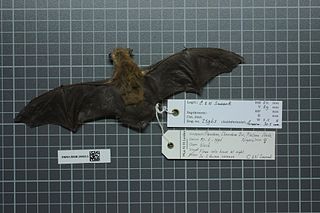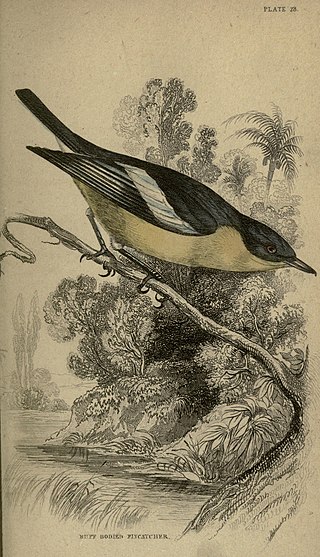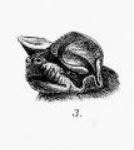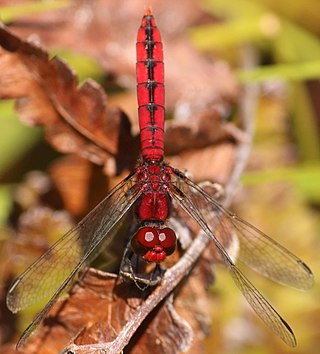
Bate's slit-faced bat is a species of slit-faced bat frequently confused with Nycteris major. It is broadly distributed and common, living throughout many parts of Africa in forests and savannas.
The tiny pipistrelle is a species of vesper bat. It can be found in Benin, Burkina Faso, Cameroon, Central African Republic, Democratic Republic of the Congo, Ivory Coast, Equatorial Guinea, Gabon, Ghana, Guinea, Kenya, Liberia, Nigeria, Senegal, Sierra Leone, and Uganda. It is found in subtropical or tropical dry forest, subtropical or tropical moist lowland forest, and moist savanna.

Beatrix's bat is a species of vesper bat in the family Vespertilionidae. It can be found in Angola, Central African Republic, Democratic Republic of the Congo, Ivory Coast, Equatorial Guinea, Gabon, Ghana, Kenya, and Nigeria. It is found in subtropical or tropical moist lowland forests.
The Bibundi bat is a species of vesper bat in the family Vespertilionidae. It can be found in Cameroon, Republic of the Congo, Uganda, and the Dzanga-Sangha Special Reserve.

The dark-winged lesser house bat is a species of vesper bat. It can be found in Angola, Benin, Cameroon, Central African Republic, Chad, Democratic Republic of the Congo, Republic of Côte d'Ivoire, Ethiopia, Gambia, Ghana, Guinea, Kenya, Malawi, Mozambique, Nigeria, Senegal, Sierra Leone, Somalia, Sudan, Tanzania, Uganda, and Zambia.

The tiny serotine is a species of vesper bat. It is found in Benin, Burkina Faso, Cameroon, Central African Republic, Chad, Republic of the Congo, Democratic Republic of the Congo, Ivory Coast, Ethiopia, Gambia, Ghana, Guinea, Guinea-Bissau, Nigeria, Senegal, Sudan, Togo, and Uganda. Its natural habitats are savanna and subtropical or tropical shrubland.

The Somali serotine is a species of vesper bat. It is found in Benin, Botswana, Burkina Faso, Cameroon, Central African Republic, Chad, Republic of the Congo, Democratic Republic of the Congo, Ivory Coast, Eritrea, Ethiopia, Ghana, Guinea, Guinea-Bissau, Kenya, Liberia, Malawi, Namibia, Nigeria, Rwanda, Senegal, Sierra Leone, Somalia, Sudan, Tanzania, Togo, Uganda, and Zimbabwe. Its natural habitat is savanna.
The beaded hylomyscus or beaded wood mouse is a species of rodent in the family Muridae. It is found in Burundi, Cameroon, Central African Republic, Republic of the Congo, Democratic Republic of the Congo, Equatorial Guinea, Gabon, and Uganda. Its natural habitats are subtropical or tropical moist lowland forest and subtropical or tropical moist montane forest.
The Stella hylomyscus or Stella wood mouse is a species of rodent in the family Muridae. It is found in Burundi, Cameroon, Central African Republic, Republic of the Congo, Democratic Republic of the Congo, Equatorial Guinea, Gabon, Kenya, Nigeria, Rwanda, South Sudan, Tanzania, and Uganda. Its natural habitats are subtropical or tropical moist lowland forest and subtropical or tropical moist montane forest.
Tullberg's soft-furred mouse or Tullberg's praomys is a species of rodent in the family Muridae in Africa. It is found in Angola, Benin, Cameroon, Republic of the Congo, Democratic Republic of the Congo, Ivory Coast, Equatorial Guinea, Gabon, Gambia, Ghana, Guinea, Liberia, Mali, Nigeria, Senegal, Sierra Leone, Togo, possibly Burkina Faso, and possibly Guinea-Bissau. Its natural habitats are subtropical or tropical moist lowland forest and subtropical or tropical moist montane forest.

The Egyptian tomb bat is a species of sac-winged bat in the family Emballonuridae. It is a medium- to large-sized microbat with a mass of approximately 30 g (1.1 oz). It is an aerial insectivore, foraging in open space. Based on individuals captured in Ethiopia, it is thought to feed predominantly on Lepidoptera, but is also known to feed on Isoptera, Coleoptera and Orthoptera.

The yellow-bellied hyliota is a species of Hyliota. It is found in Angola, Burkina Faso, Burundi, Cameroon, Central African Republic, Republic of the Congo, Democratic Republic of the Congo, Ivory Coast, Ethiopia, Gabon, Gambia, Ghana, Guinea, Guinea-Bissau, Kenya, Malawi, Mali, Mozambique, Nigeria, Rwanda, Senegal, Sierra Leone, South Sudan, Tanzania, Togo, Uganda, and Zambia. Its natural habitat is subtropical or tropical dry forests.

The blue-billed malimbe or Gray's malimbe is a species of bird in the family Ploceidae.

The Gambian epauletted fruit bat is a species of megabat in the family Pteropodidae. It is found in Benin, Burkina Faso, Cameroon, Central African Republic, Chad, Democratic Republic of the Congo, Ivory Coast, Ethiopia, Gambia, Ghana, Guinea, Guinea-Bissau, Liberia, Mali, Niger, Nigeria, Senegal, Sierra Leone, South Sudan, Sudan, and Togo. Its natural habitats are subtropical or tropical dry forests and savanna.

The Sierra Leone free-tailed bat is a species of bat in the family Molossidae. It is found in Cameroon, Ivory Coast, Equatorial Guinea, Gabon, Ghana, Guinea, Kenya, Liberia, Mozambique, Nigeria, Sierra Leone, Tanzania, Togo, and possibly the Central African Republic, the Republic of the Congo, and the Democratic Republic of the Congo. Its natural habitats are subtropical or tropical dry forests and subtropical or tropical moist lowland forests.

The Angolan free-tailed bat is a species of bat in the family Molossidae. It is found in Angola, Benin, Botswana, Burkina Faso, Burundi, Cameroon, the Republic of the Congo, the Democratic Republic of the Congo, Ivory Coast, Eswatini, Ethiopia, Gambia, Ghana, Guinea, Kenya, Malawi, Mali, Mozambique, Namibia, Niger, Nigeria, Rwanda, Senegal, Sierra Leone, Somalia, South Africa, South Sudan, Sudan, Tanzania, Togo, Uganda, Zambia, and Zimbabwe. Its natural habitats are dry and moist savanna, although it is sometimes found at the edges of woodlands.

The Mongalla free-tailed bat is a species of bat in the family Molossidae. It is found in Burkina Faso, Cameroon, Democratic Republic of the Congo, Ivory Coast, Ghana, Kenya, Mali, Sudan, and Uganda. Its natural habitats are dry savanna, moist savanna, and subtropical or tropical seasonally wet or flooded lowland grassland.

The Bini free-tailed bat is a species of bat in the family Molossidae found in West and Central Africa. Its natural habitat is subtropical or tropical moist lowland forests.

The redbreast tilapia is a species of fish in the family Cichlidae. It is found widely in the southern half of Africa. Its natural habitats are freshwater lakes and freshwater marshes. It is known as the redbreast kurper in South Africa.

Aethriamanta rezia is a species of dragonfly in the family Libellulidae. Described by William Forsell Kirby in 1889, it is found in Angola, Botswana, the Democratic Republic of the Congo, Ivory Coast, Gambia, Ghana, Guinea, Kenya, Liberia, Madagascar, Malawi, Mozambique, Namibia, Nigeria, Senegal, South Africa, Tanzania, Togo, Uganda, Zimbabwe, and possibly Burundi. Its natural habitats are subtropical or tropical moist lowland forests, moist and dry savanna, subtropical or tropical moist and dry shrubland, rivers, marshes, and other wetlands.
















